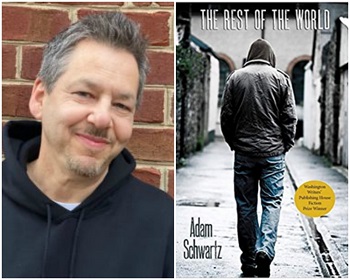The longtime educator's new story collection seeks to capture (and honor) the voices of Baltimore teens.

Adam Schwartz’s The Rest of the World recently won the Washington Writers’ Publishing House 2020 award for fiction. His eight-story collection chronicles the lives of Baltimore teens as they persevere while coping with hair-trigger violence, absent parents, and their own often conflicting impulses. Schwartz, who has taught in the Baltimore City public schools for more than 20 years, draws inspiration from his students’ resiliency, resourcefulness, and persistence.
The circumstances of your characters are almost unbelievably difficult, and their responses to them are often violent. Yet you have said these stories are an affirmation about Baltimore’s young people. In what sense is this so?
Baltimore can be a violent city — especially for people living in struggling communities. I long ago ran out of enough fingers and toes to count all of the students I’ve known who have been murdered. Why has Baltimore been safe for me but unsafe for many students at my school? Why, at the end of the school day, do some kids have to put on their hard faces to get home, but I don’t? How does the threat of violence shape their views and the possibilities they see for themselves in the world?
I didn’t set out to write a book with characters scarred by violence, but perhaps these stories are, in part, an expression of the anger I feel at a nation that continues to betray the hopes of children. What kind of a country, year after year, puts kids through this?
In Between the World and Me, an epistle the author wrote to his son, Baltimore native Ta-Nehisi Coates offers a powerful, firsthand account of these pressures: “When I was about your age, each day, fully one-third of my brain was concerned with who I was walking to school with, our precise number, the manner of our walk, the number of times I smiled, who or what I smiled at, who offered a pound and who did not — all of which is to say that I practiced the culture of the streets, a culture concerned chiefly with securing the body.”
The mazy pressures Ta-Nehisi Coates navigated in the late 80s are the same ones many young men at my school still endure. But Baltimore isn’t just its problems. It’s also the people who rise above them. My hope is that the stories in my book are mostly about kids lifting each other up and resisting despair, finding solace in loved ones, holding on to their ideals, refusing to give up on themselves or loved ones, and striving to overcome the turmoil around them.
The adults in these stories are shadow figures, either too exhausted to exert any control over their teenagers or downright predatory. As a consequence, the teens take care of themselves and, frequently, younger siblings. Would you agree that this situation forces them to grow up too fast and robs them of the opportunity to consider the possibilities of the rest of the world?
The problems of Baltimore’s struggling neighborhoods are the problems bred by entrenched, systemic inequities: redlined neighborhoods; disinvestment — public and private; the economic insecurity and isolation borne of few job opportunities and lousy public transportation; municipal neglect; and the policies of mass incarceration. The instabilities and hazards created by these injustices fall hardest on children. They’re the ones who have to figure this out — have to figure out how to navigate the still-unfolding fallout of our country’s abominable legacy of racial injustice.
Many Baltimore kids are growing up in loving homes with solid family supports. But Baltimore still lays a lot of obstacles at their feet. So the characters in my stories are coming of age in a city that tests their ideals, tests their resilience, tests their beliefs in their own possibilities. In this way, they are initiation stories in which characters undergo experiences that alter how they see themselves and the world around them.
Your dialogue is especially rich. Where does your ear for subtle conversation come from?
Thank you. The students’ stories — both the struggles and the triumphs — stick in my head, their voices stick in my ear, and the striving they do against steep challenges evokes my hopes for them. There are days where I’m almost involuntarily inhabiting some aspect of human experience I’ve been invited into.
“Carmen an Ant,” a story of yours about a shooting outside a school and young love, will be published in Raritan. Originally, the Tahoma Literary Review accepted it, but then a sensitivity reader found issues with its “insensitive characterizations and tinned-eared diction,” so you withdrew it. Cultural appropriation is an issue many writers and publishers are grappling with. Do you think the issue has some legitimacy, or do you think that we should be free to tell each other’s stories, regardless of race or background?
I think often about these tensions. And I do worry sometimes that I’ve trespassed by creating characters whose struggles cannot be disconnected from our country’s vile history of racial injustice — injustices I’ve never had to deal with. Artists who perpetuate stereotypes or exploit the traditions of a culture should be condemned. I hope my stories don’t do that. I hope my stories honor the strength, will, generosity, and disparate presentations of humanity so many Baltimore teens have shown me over the years. I hope race is but one strand in these characters’ identities. But, no, I don’t believe that artists should be made to confine the subjects of their work to people more or less like themselves, living in milieus more or less like their own.
Patricia Schultheis is the author of St. Bart’s Way, a collection of stories also set in Baltimore, and which won the Washington Writers’ Publishing House award for fiction in 2015.

